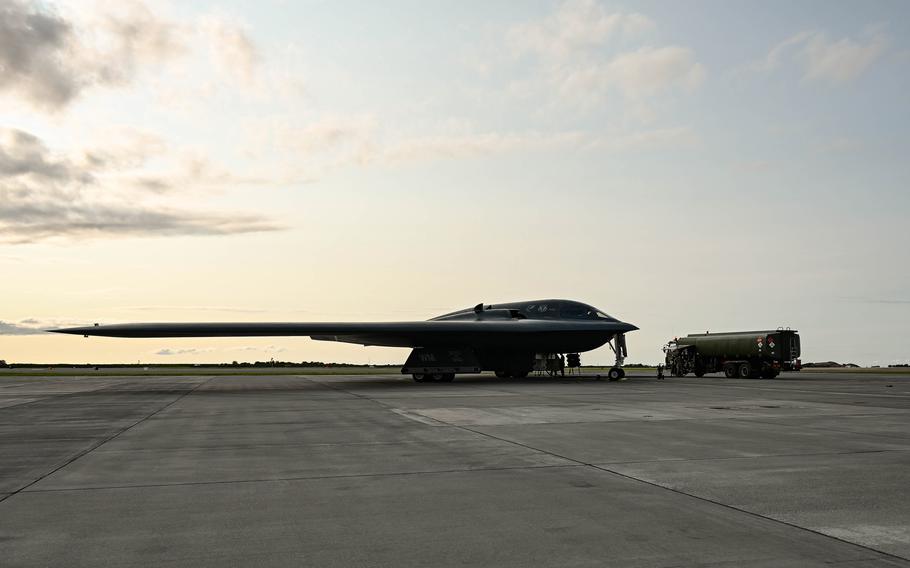The US, UK, and Norwegian Air Forces conducted multi-domain military drills over the Arctic. The trilateral exercise included strategic assets such as B-52 Stratofortress and F-35 Lightning II aircraft.
According to an official press release published by the US Air Force in Europe—Air Forces Africa (USAFE), Exercise APEX Buccaneer took place on December 3 near the Arctic Circle in the high north.
“The air assets included Norwegian F-35 Lightning IIs and P-8 Poseidon aircraft, U.K. F-35 Lightning IIs, and Eurofighter Typhoons, a U.K. RC-135 Rivet Joint reconnaissance aircraft, and U.S. B-52 Stratofortress bombers, KC-135 Stratotankers, a U-2 Dragon Lady and F-35 Lightning IIs,” noted the release. The exercise was led by Norway and was aimed at bolstering interoperability among NATO allies.
The American, Norwegian, and British troops rehearsed information sharing across several platforms to create a common image of the mock battlefield before dropping weapons on it.
Only the US B-52 bomber dropped payloads directed onto the targets by Norwegian joint terminal attack controllers stationed on the ground.
“Multi-domain integration is essential for leveraging the full spectrum of capabilities,” said Gen. James Hecker, USAFE commander. “It creates a more adaptable, resilient, and precise military force capable of addressing diverse and evolving threats across the battlespace.”
The allies trained on one major strategy: the multi-domain find, fix, track, and target (F2T2). “Find” refers to searching the battlefield for possible targets, whereas “fix” refers to pinpointing the precise location of the potential target and determining that it is a worthy target. In addition, “Track” refers to monitoring the precise location and identity of the target, whereas “target” refers to selecting and employing the appropriate instrument to eliminate or otherwise impact the target.
“The trilateral exercise allowed for the seamless integration of the F-35 data-sharing capabilities, as pilots from all three nations exchanged real-time tactical information, creating a unified air picture and demonstrating the aircraft’s ability to operate as a force multiplier,” emphasized the release.
The development comes amid increased Russian activity in the Arctic, a region that is expected to become the next big flashpoint in the future. The US and its NATO allies in the higher north, including Norway, Sweden, and Finland, have expressed concern over the increase in Russian military activity, especially over the Baltic and the Barents Sea.
These states have made concerted efforts to fortify their defenses and sought closer integration with the US and other allies in Europe since Russia launched an invasion of Ukraine in February 2022.
Additionally, the Arctic region has assumed significance due to climate change, which has resulted in a rapid decrease in the Arctic ice cap, thus opening new sea lanes. The US, for one, is wary of Russia’s growing commercial and military ambitions in the region, as highlighted by it in the ‘Arctic Strategy’ released earlier this year.
This has led to increased US bomber activity and enhanced cooperation with allies to achieve regional synergy and strategic advantage. Just over a week ago, on November 26, two B-52s were intercepted by Russian Su-27 fighters close to Kaliningrad, which is located on the Baltic Sea coast.

US Bombers Are Active In The Arctic
The US has enhanced the presence of its nuclear-capable bombers in the region with its ‘Bomber Task Force’ (BTF) missions to deter Russia. The United States has been conducting strategic bomber missions in Europe with the primary objective of introducing their crews to the region and nurturing relationships with NATO allies and partners.
For instance, two US Air Force B-52H Stratofortress bombers from the 20th Expeditionary Bomb Squadron trained for a simulated weapons drop mission in Finland on November 25 as part of Bomber Task Force 25-1. The bombers integrated with Swedish Air Force Saab JAS 39 Gripens and Finnish F/A-18C Hornets.
In May this year, the B-52 bombers conducted integrated operations with NATO Allies and international partners, including Denmark, Finland, Germany, Lithuania, Morocco, Norway, Poland, Spain, Sweden, and the United Kingdom, on a month-long deployment as part of Bomber Task Force 24-3 (BFT 24-3).
Last year was particularly significant as it saw multiple firsts involving US bombers in the Arctic. In June 2023, the USAF deployed its B-1B Lancer bombers to Sweden for the first time, further bolstering its defense. At the time, the service said, “US Forces have conducted exercises and training in the Arctic region, but the landing fortifies not only the friendship between the US and Sweden but the collective defense of Europe.”

Later that year, in August 2023, another bomber—the B-2 Spirit—carried out a historic hot pit refueling at Orland Air Base, Norway, marking the stealth bomber’s first landing in the Scandinavian nation. At the time, the service said that the practice of hot pit refueling within NATO nations enables the B-2 to expand its fuel range while minimizing its downtime on the ground, ultimately enhancing the capacity to bolster combat airpower across the European theater.
All things considered, the US believes that the more they can combine forces and equipment for strategic mobility around Europe, the more equipped they will be to handle security threats in the years to come–primarily from Russia and the growing alliance between Russia and China in the Arctic.
At this juncture, all Arctic Council members (Canada, Denmark, Finland, Iceland, Norway, Russia, Sweden, and the US) except Russia are also NATO members.
- Contact the author at sakshi.tiwari9555 (at) gmail.com
- Follow EurAsian Times on Google News




